This is my go-to easy green juice recipe! You can use a high-speed or regular blender, no juicer required. Just blend and strain! Plus, the juice is packed with healthful and tasty ingredients.
Clik here to view.
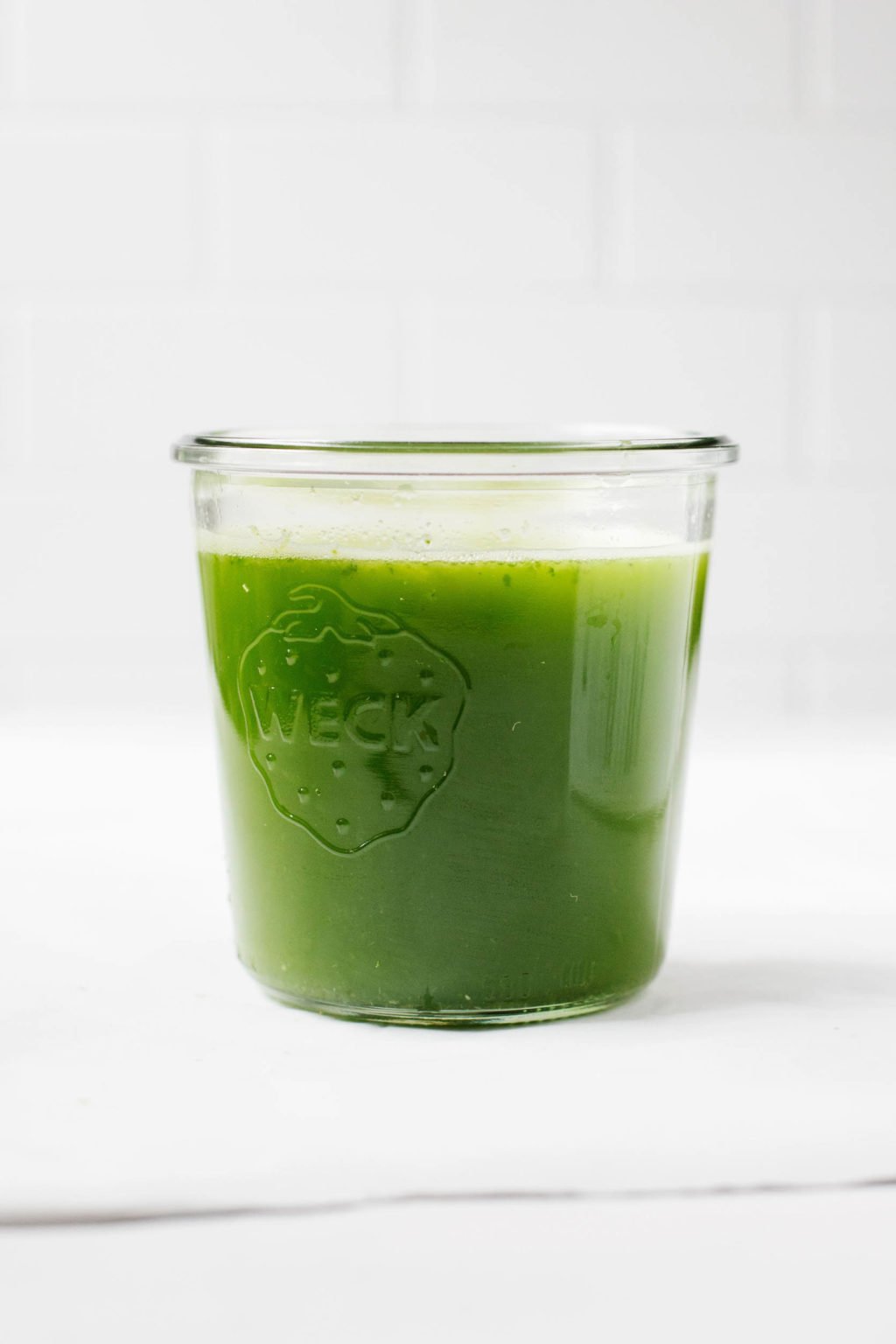
I enjoy a green juice.
Green juice refreshing and sweet, and I like sweet things. I also like that green juice presents an easy way to get the benefits of green veggies without having to sit down and eat a massive bowl of them.
What I don’t like about green juice is the fact that it can be time-consuming and that most recipes require an expensive juicer. I don’t drink juice often enough to justify having a juicer at home (appliance space is limited in my apartment!).
So what’s an occasional green juice drinker to do?
This easy green juice recipe is the answer. It’s made in a blender—any blender—and then strained with cheesecloth or a nut milk bag. It’s flavorful and full of micronutrients, but you don’t need a fancy juicer to make it.
What is green juice, anyway?
Green juice gets a lot of hype, but the idea behind making it is simple: extract micronutrients and water from green vegetables while removing the fiber.
We all know that fiber is important for heart health and digestive health. We also know that it’s associated with the prevention of some types of cancer. So, why would we want to remove it?
Two reasons that I can think of.
Juicing for efficiency
The first one is that fiber is really filling. This can be a good thing, of course. But the cool thing about a green juice is that it affords you all of the micronutrients of a bunch of green veggies in an efficient, easy-to-take dose.
My easy green juice recipe calls for half a large cucumber, some celery a bunch of spinach, three stalks of kale, parsley, half a navel orange, and a pear.
If you were to eat all of those things at once, you’d get full pretty quickly (before you had time for protein or starch or any other part of your meal). Juicing allows you to take in the vitamins and minerals without filling up too quickly or too much.
This can be really great for people who are busy or on-the-go. They may not have time to eat big heaps of vegetables, but they may still wish to get the nutrients that those veggies afford.
It’s also helpful for people who like the benefits of green vegetables, but don’t love the taste. Or people who are learning to love the taste, but aren’t quite there yet 😉
Juicing for sensitive or impaired digestion
The other group of people who can benefit from juicing are those with sensitive or impaired digestive function. This might include people with IBS, IBD (Crohn’s Disease and ulcerative colitis), or any other digestive condition that makes it hard to eat lots of fiber.
Yes, fiber is good for digestive health and function. But large amounts of fiber can wreak havoc on IBD patients who are flaring, and it can be really irritating to those with IBS-D as well.
I have a lot IBS and IBD clients, as well as clients who struggle with what might simply be called a sensitive digestive tract. It’s important for me to help those clients continue getting fiber in their diets without overwhelming them with too much fiber at once.
Green juice can be a great solution here. It’s a light snack or meal component that delivers lots of vitamins, minerals, and electrolytes without triggering peristalsis or activating a sensitive digestive system.
To be clear, I don’t believe that “digestive rest” is beneficial as a prolonged habit, at least not for most people. In fact, I think that too much digestive rest can weaken peoples’ digestive systems.
It’s a phenomenon I’ve seen many times in my dietetics practice—a client with digestive distress has started replacing meals with liquids and eliminating a lot of foods in the hope of feeling better. But the large and small intestines are made of a lot muscle, and they function better when that muscle is worked.
There’s no rule that fits everyone. I meet my clients where they are. Many of them are working to heal impaired digestion, and healing is best served with moderate, carefully controlled doses of fiber. Juicing can help to maintain nutrient levels while that goal is met.
How I incorporate green juice into my diet
I like to enjoy green juice as a snack or with a meal. For me, it functions as a supplement of sorts: a concentrated shot of nutrition.
I know that juices and juicing are often tied up with fasting. Fasting works for some people, and it can be an efficient way to create a calorie deficit, if that’s person’s goal.
Given my eating disorder history, which included replacing necessary meals with green juice and “fasting till lunch,” I don’t mess around with fasting at all.
I also don’t recommend fasting to my nutrition clients. From what I can tell, the evidence in favor of fasting for health (autophagy and blood sugar control) isn’t strong enough to outweigh the very danger of fasting as a trigger for disordered eating.
I also worry about adequate nutrition with skipped meals—each one of those is a missed opportunity to get vital protein, calcium, iron, and other nutrients. To say nothing of inconvenience and discomfort: eating is part of socializing and enjoying life!
Juice as a sweet, hydrating snack or within-meal beverage? That’s something I can definitely embrace. If I need the green juice to keep me fuller, longer, then I sometimes blend in avocado after I’ve strained it.
Benefits of Juicing vs. Blending
There seems to be a big debate between proponents of juicing and blending, respectively. Fans of juicing argue that it is more conducive to healing than blending.
Champions of blending/smoothies point out that removing fiber from vegetables and fruits is taking away an important nutrient. They also argue that removing fiber, which helps to control the release of glucose from food into the bloodstream, can blood sugar.
I think there are benefits to both blending and juicing. And they’re not mutually exclusive: both types of drinks can have a role in a balanced diet.
For the average person with no digestive impairment, I think smoothies will offer more opportunity for balanced nutrition (protein and fiber included). And I do think that smoothies are better than juices when it comes to blood sugar control, unless the juices in question are very low sugar. (Those aren’t the type of juices that I enjoy!)
I think juices work nicely as a micronutrient supplement and can be beneficial for those with sensitive digestive systems. I also love the way they taste.
Especially this refreshing, sweet, easy green juice recipe. And in some ways it’s the best of both worlds, in that it uses a blender to create a juice 😉
How to make green juice at home
There are two simple steps to making this easy green juice. First, blend all of the juice ingredients together. You can use any blender for this! A high-speed, fancy blender isn’t necessary.
I have a Breville Super Q, and I absolutely love it, but I’ve made the juice using a Vitamix in the past. And I’ve made it with the basic, inexpensive blender that came before that.
If you’re working with a blender that isn’t very powerful, you can omit the celery and ginger (or use pre-minced ginger instead). And be sure to peel your cucumber.
Begin by piling all of your ingredients into the blender.
Clik here to view.

Blend for 30-120 seconds, or as long as it takes to get things evenly blended. A high speed blender will do this quickly, while a regular blender might need a little more time.
Then, pour the blended vegetable and fruit mixture through cheesecloth or a nut milk bag. I like this one and this one.
Clik here to view.
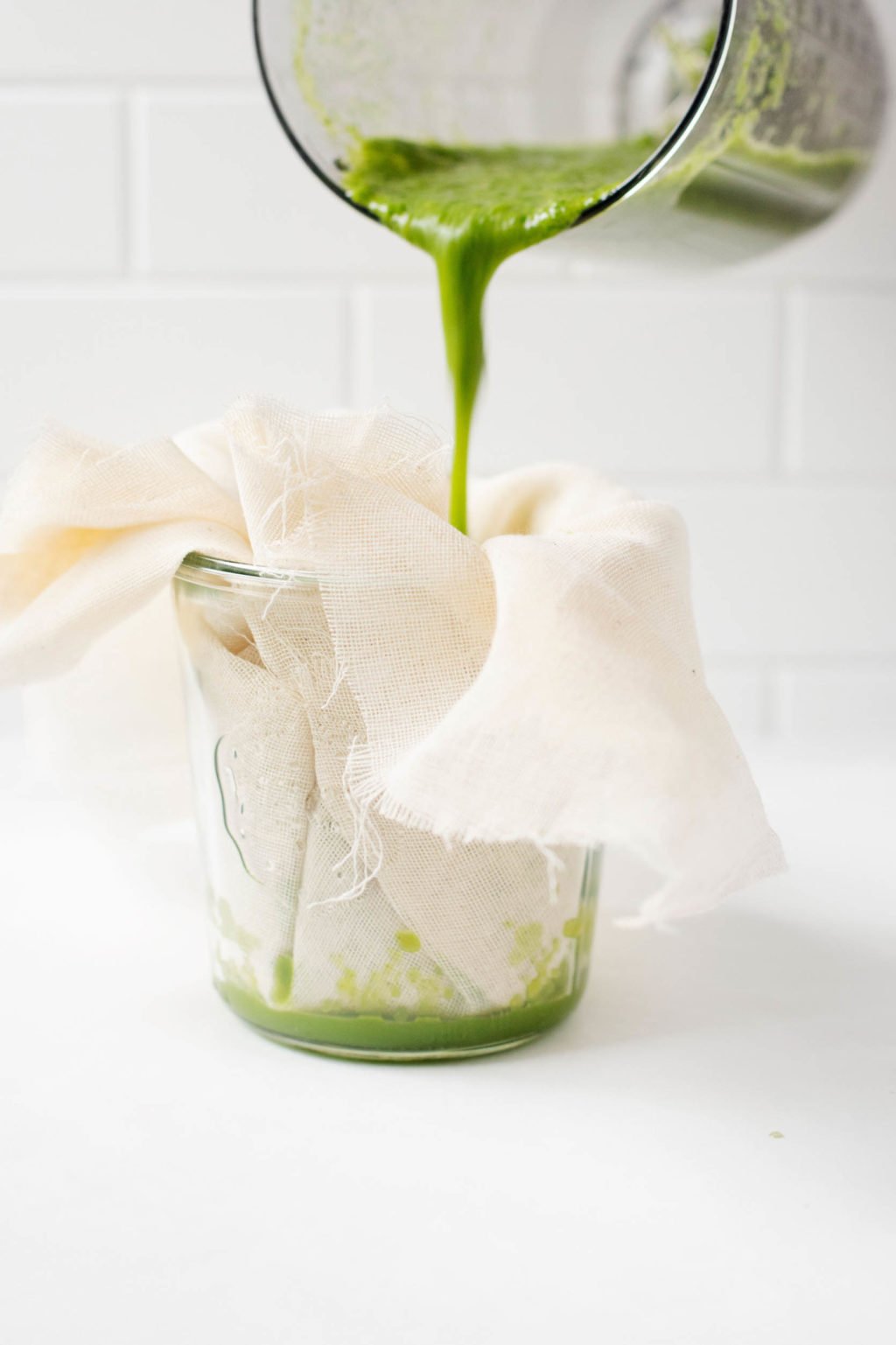
Squeeze the cheesecloth or nut milk bag tight to extract as much fresh juice as you can.
Clik here to view.
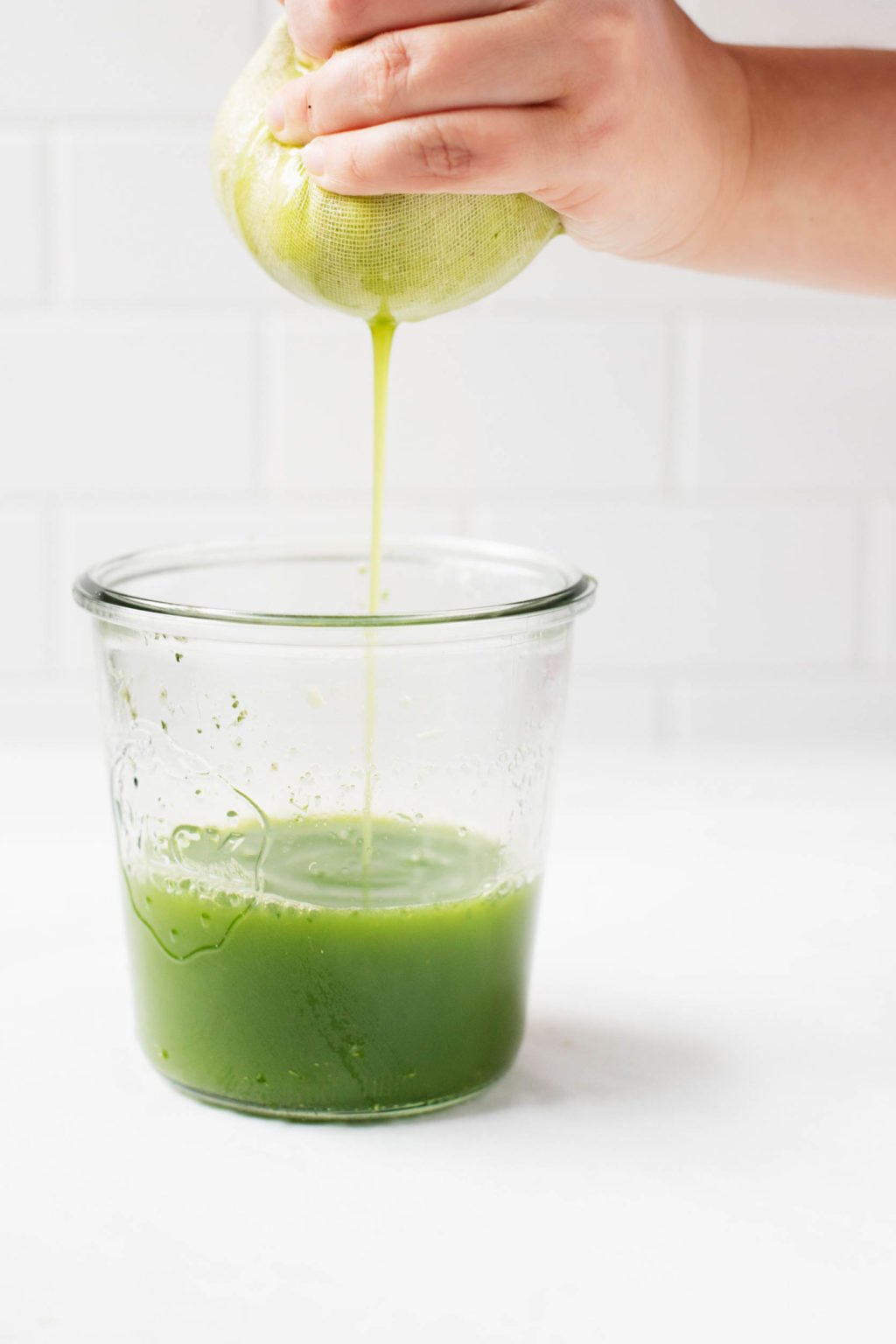
It’s that easy!
The beauty of this easy green juice recipe is that you won’t have to clean a juicer, which is a daunting task. You won’t need to spend money on a juicer in the first place. And you’ll have juice within minutes.
Using a little elbow grease to strain the juice through the cheesecloth is the toughest part of the process.
Does blending juice destroy nutrients?
Of course, most green juices are made with a juicer. And many of the best juicers are designed to avoid oxidation—the process by which oxygen reduces the quality of juice.
Blending does introduce some oxygen into this easy green juice recipe. It’s more oxidized than juice from a blender, and so it doesn’t keep for very long. Certainly not as long as a bottled juice from a juice shop or juice from a high-quality juicer. I recommend drinking right away, or within a few hours if you store it in the fridge.
But that’s OK! Within the context of a well-rounded, healthy diet, it’s OK if your cup of green juice isn’t maximally nutritious. If it tastes good and delivers some important micronutrients—which this easy green juice recipe definitely does—that’s still a win.
Do I have to strain my green juice?
Of course not! You can do whatever you want to do.
Not straining the juice will essentially turn it into a smoothie. If that’s what you’re craving, then by all means, skip the cheesecloth and go straight to drinking your green drink.
Easy green juice ingredients
There are many thousands of potential green juice formulas, or mixtures of vegetables, greens, and fruits. This is just my favorite, the one I’ve come to rely on for juice at home.
It encourages me to get some Vitamin C from citrus, has enough fruit for sweet flavor (which I like!) and also allows me to get plenty of green goodness from parsley, kale, and cucumber. Here’s what’s in it:
Cucumber
This helps to make the juice juicy and hydrating! If you use a blender that isn’t very powerful, I recommend peeling first. If your blender is powerful, then no need to peel.
Celery
A good source of naturally occurring sodium for electrolytes. Celery works best in a strong blender, so you can omit or add extra cucumber in its place if you don’t think it will blend up easily in the blender you have at home.
Spinach
I like using two types of greens, spinach and kale, in this juice. You could use chard, collards, arugula, or baby kale in place of spinach.
Kale
My favorite leafy green, so it’s no surprise that it ends up in my juice. You can substitute chard, beet greens, collard greens, or mustard greens for kale. Or you can substitute additional spinach.
Parsley
I love using this for flavor and health benefits. Sometimes I use cilantro in its place—I’m in the cilantro lover’s club!
Lemon + ginger
Both of these ingredients give the juice a little zing. But they’re both optional! You can omit either if it’s not to your taste. If your blender isn’t super strong, you can use pre-minced ginger.
Orange
Provides some sweetness, some acid, and plenty of Vitamin C. I usually use a regular navel orange, but two mandarin oranges or a different type of orange would also work well.
Apple or pear
Both of these fruits can provide lovely, mellow sweetness to the easy green juice recipe. Pear is my preference—it’s so subtle and sweet—but I use apple often, too.
What should I do with leftover juice pulp?
Great question! One of the downsides of making juice at home is having a lot of fibrous vegetable/fruit pulp that can go to waste.
Fortunately, you don’t have to throw this mixture away. If you compost at home, you can compost it. If you’re lucky enough to have a garden, you can use it as fertilizer.
You can also use the leftover juice pulp in additional recipes! My favorite is these juice pulp crackers. I like to use beet pulp in these beet balls (great with zucchini noodle or regular spaghetti). When I have carrot pulp, it usually goes in these carrot falafel or this carrot avocado pâté. I also bake with carrot pulp (muffins or quick bread). Baking is a great use
And there are a lot more excellent resources on what to do with leftover juice pulp online!
More juicing tips + recipes
I may not own a juicer nowadays, but I used to own one. At that time, I drank a lot of homemade juice, and I loved it.
So I’ve still got a lot of great juicing recipes and resources on the blog! Some of my favorites:
- My top ten favorite juice recipes
- Sweet potato vegetable juice
- Refreshing green juice recipe (cucumber, mint, pear)
- Question of the week: blending vs. juicing
Clik here to view.
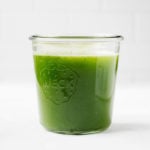
Green Juice Recipe + Juicing Nutrition Tips
Equipment
- blender
Ingredients
- 1/2 large cucumber (peel if you have a regular blender, no need to peel for a high speed blender)
- 2 medium stalks celery, cut into 3-inch pieces
- handful baby or regular spinach
- 3 stalks stemmed curly kale
- handful curly or Italian parsley
- 1/2 lemon, skin cut off
- 1/2 navel orange, skin cut off
- 1-inch piece peeled ginger
- 1 pear or apple, cored and quartered
- 2/3 cup water (more as needed)
Instructions
- Add all ingredients to your blender. Blend all ingredients together for 30-120 seconds, or as long as it takes to create an evenly blended mixture. Add up to an additional 1/4 cup water as needed to facilitate blending.
- Cover the mouth of a roomy mason jar with two layers of cheesecloth or a nut milk bag. Pour the juice into the mason jar, straining through the cheesecloth.
- Give the cheesecloth a good squeeze to extract as much juice as possible.
- Drink juice immediately, or cover the mason jar and refrigerate for up to a few hours.
Video
Clik here to view.
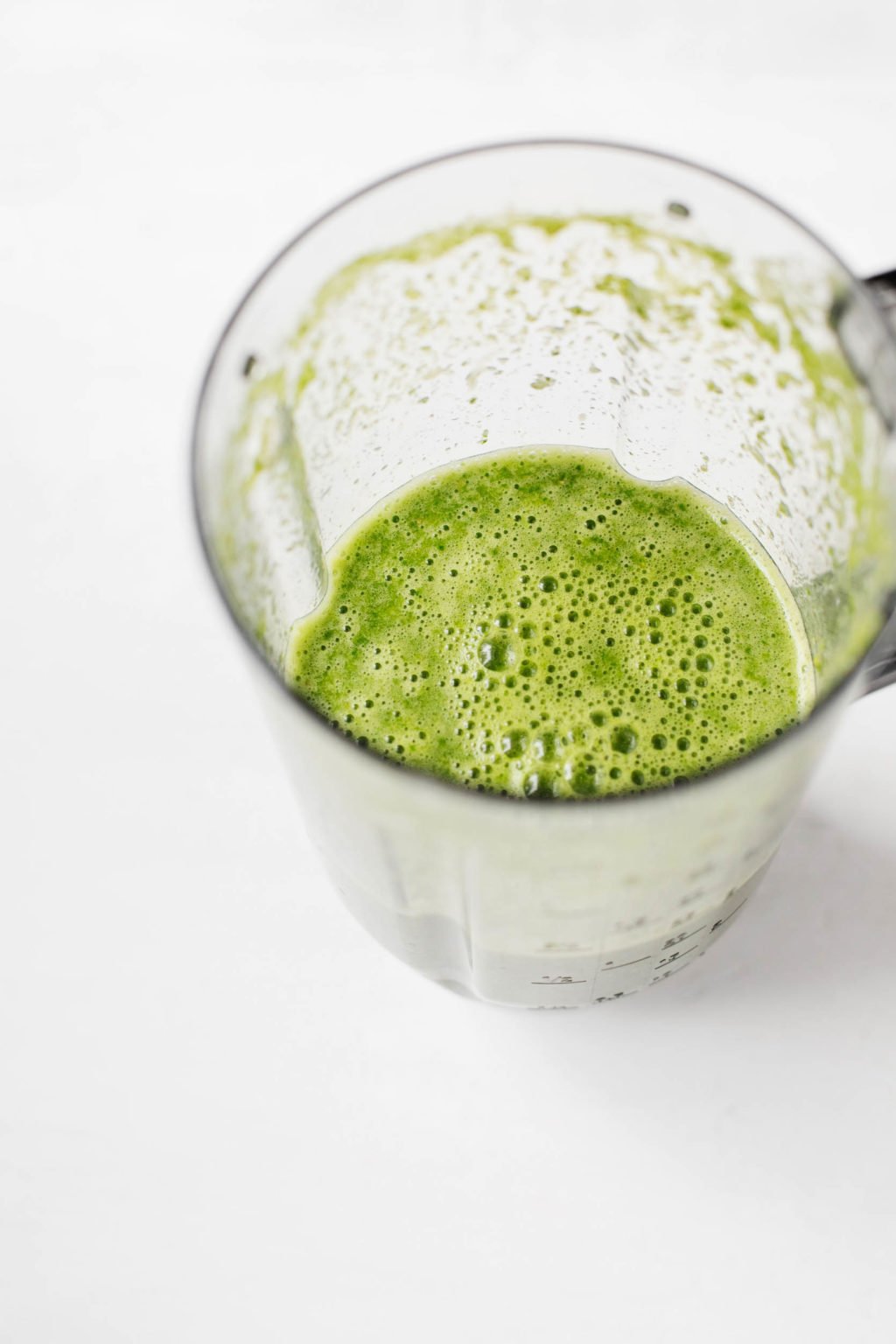
Hopefully this recipe will give you an accessible way to enjoy green juice at home. Feel free to change around the proportions of fruits and veggies so that it becomes your own. Adaptation and flexibility is what this easy green juice recipe is all about.
Happy sipping!
xo
The post Easy Green Juice Recipe + Juicing Nutrition Tips appeared first on The Full Helping.